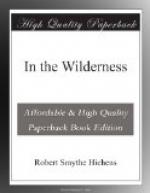The American deer in the wilderness, left to himself, leads a comparatively harmless but rather stupid life, with only such excitement as his own timid fancy raises. It was very seldom that one of his tribe was eaten by the North American tiger. For a wild animal he is very domestic, simple in his tastes, regular in his habits, affectionate in his family. Unfortunately for his repose, his haunch is as tender as his heart. Of all wild creatures he is one of the most graceful in action, and he poses with the skill of an experienced model. I have seen the goats on Mount Pentelicus scatter at the approach of a stranger, climb to the sharp points of projecting rocks, and attitudinize in the most self-conscious manner, striking at once those picturesque postures against the sky with which Oriental pictures have made us and them familiar. But the whole proceeding was theatrical.
Greece is the home of art, and it is rare to find anything there natural and unstudied. I presume that these goats have no nonsense about them when they are alone with the goatherds, any more than the goatherds have, except when they come to pose in the studio; but the long ages of culture, the presence always to the eye of the best models and the forms of immortal beauty, the heroic friezes of the Temple of Theseus, the marble processions of sacrificial animals, have had a steady molding, educating influence equal to a society of decorative art upon the people and the animals who have dwelt in this artistic atmosphere. The Attic goat has become an artificially artistic being; though of course he is not now what he was, as a poser, in the days of Polycletus. There is opportunity for a very instructive essay by Mr. E. A. Freeman on the decadence of the Attic goat under the influence of the Ottoman Turk.
The American deer, in the free atmosphere of our country, and as yet untouched by our decorative art, is without self-consciousness, and all his attitudes are free and unstudied. The favorite position of the deer—his fore-feet in the shallow margin of the lake, among the lily-pads, his antlers thrown back and his nose in the air at the moment he hears the stealthy breaking of a twig in the forest—is still spirited and graceful, and wholly unaffected by the pictures of him which the artists have put upon canvas.
Wherever you go in the Northern forest you will find deer-paths. So plainly marked and well-trodden are they that it is easy to mistake them for trails made by hunters; but he who follows one of them is soon in difficulties. He may find himself climbing through cedar thickets an almost inaccessible cliff, or immersed in the intricacies of a marsh. The “run,” in one direction, will lead to water; but, in the other, it climbs the highest hills, to which the deer retires, for safety and repose, in impenetrable thickets. The hunters, in winter, find them congregated in “yards,” where they can be surrounded and shot as easily as our troops




